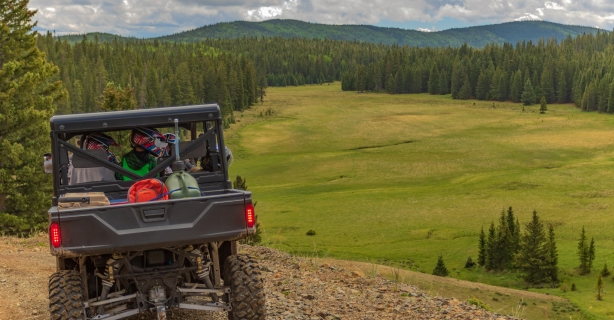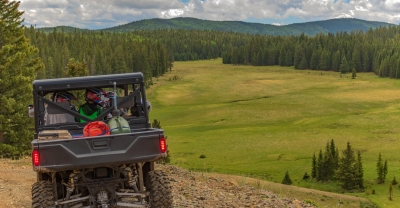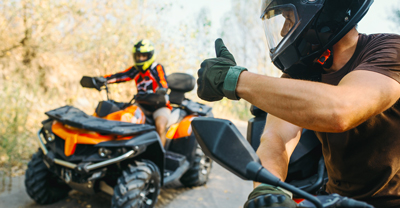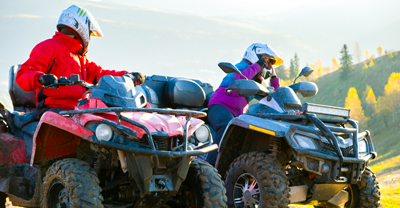UTVs explained: What they are, what they do, and why they matter


0 min. read
UTVs haul, climb, and cover tough ground. Thinking about getting one? Start here.
From job sites to trails, UTVs are built for both work and fun—but the world of off-road vehicles can be a maze of acronyms. You’ve probably heard of ATVs, but UTVs are a different ride altogether.
This guide covers what makes UTVs unique, how to choose the right one for your lifestyle, and why off-road insurance matters.

Get a free off-road insurance quote from Dairyland.
What is a UTV?
A UTV—short for Utility Task Vehicle—is a tough off-road vehicle designed for hauling, towing, and navigating rugged terrain. Unlike ATVs, UTVs feature side-by-side seating for two to six passengers, along with car-style controls like a steering wheel and foot pedals.
Most models include a roll cage, seatbelts, and sometimes doors, making them a safer choice for work or recreation.
Utility at its core
The "Utility" in UTV is no accident. These machines are built with a focus on function—often featuring a rear cargo bed, high towing capacity, and strong payload ratings. They’re made to carry gear, tools, supplies, or even wild game across challenging ground.
Many UTVs also include four-wheel drive (4WD) or all-wheel drive (AWD) systems for better traction in mud, snow, or rocky terrain.
Where UTVs shine
UTVs are built to handle a wide range of jobs and terrain. Whether you're managing property, working the land, or heading off-road for fun, many owners find they offer the power, control, and durability to take on what other vehicles can’t. Recreation—like trail riding and backwoods exploring—is also a major reason people choose to own one.
Here are some of the most common ways UTVs are used:
Farming and agriculture: Haul feed, move tools, check fence lines, or cover large fields with ease
Construction sites: Transport materials, tow equipment, and get crews where trucks can’t
Property maintenance: Tackle landscaping, plow snow, haul firewood, or tow trailers
Outdoor recreation: Head out hunting, pack up for a camping trip, or explore hard-to-reach trails
Commercial use: Handle groundskeeping, maintenance, and transport across parks, resorts, or industrial sites
UTV vs. ATV: What’s the difference?
Choosing between the two often comes down to how you plan to use the vehicle, who’s riding, and how much you want to spend. UTVs offer more comfort and utility, making them a go-to for work and group recreation. ATVs tend to be more compact, agile, and budget-friendly—popular with solo riders and sport users.
Both are off-road vehicles, but the experience, capabilities, and features differ:
UTVs feature side-by-side seating for multiple passengers
ATVs have a straddle-style seat, typically for one or two riders
UTVs use a steering wheel and foot pedals
ATVs use handlebars and hand/foot controls
UTVs come with a roll cage and seatbelts for enhanced safety
ATVs have an open design with less built-in rollover protection
UTVs are designed for work, but are also great for recreation
ATVs are built for recreation, with some utility use

Get a free ATV insurance quote from Dairyland today.
What to know about UTV ownership
UTV ownership tends to be highest in states with large rural areas or strong off-road recreation cultures, including Texas, Arizona, and parts of the upper Midwest. If you're planning to buy—or already own—a UTV, here are a few things to keep in mind:
Insurance: UTV coverage isn’t always required, but typically recommended. It can help protect against theft, damage, or accidents, and some trails or events may require proof of coverage.
Maintenance: UTVs are built tough, but regular upkeep still matters. That includes oil changes, brake checks, and tire maintenance to help keep your vehicle running reliably.
Street use: Planning to drive your UTV on the road? You'll likely need modifications like lights, mirrors, and turn signals, along with local registration to meet state requirements.
Storage: If your UTV is stored outdoors, security is key. Theft prevention tools and proper insurance can help protect your investment.
Transporting your UTV
Many new owners focus on where they'll ride but overlook how they'll get there. UTVs typically need to be trailered, especially if they’re not street legal. That means you'll need a compatible trailer, proper tie-down equipment, and a vehicle with enough tow capacity.
State laws and rider requirements
Before taking your UTV beyond your own property, check local laws to avoid surprises. Some states require riders to meet minimum age requirements or complete safety training—especially when operating on public land.
Rules can vary by state, and some counties or municipalities may have additional ordinances. It’s worth researching the regulations in any area where you plan to ride to stay compliant and safe.
Choosing the right UTV
UTVs range from heavy-duty work models to high-performance sport versions. Brands like Polaris®, Honda®, and Yamaha® offer options with features like upgraded suspension, strong towing capacity, and enhanced safety tech. The right fit depends on how you plan to use it—and which features matter most for your day-to-day.
Start by thinking about how you’ll use your UTV. Your answers can help point you toward the right category or build:
Working on land or job sites? Look for utility-focused models with higher payload and towing ratings.
Exploring trails with friends or family? Prioritize comfort, seating capacity, and ride stability.
Participating in races or adventure events? Sport models with performance suspension and speed-tuned handling are designed for challenging terrain.
Considering a UTV? Make sure you're covered
Owning a UTV is a big move—whether for work, play, or both. Getting the right insurance can help protect your investment and keeps you covered where it counts. Coverage requirements can differ by state, and may depend on whether you’re using your UTV on private property, public trails, or for commercial purposes.
That’s where we come in. Dairyland®, a brand of the Sentry Insurance Group, offers flexible off-road coverage options designed to fit how—and where—you ride. Have questions? Our team is here to help. Call us at 866-287-9640 to talk through your coverage needs.

Get your free off-road insurance quote from Dairyland.
*All product names, logos, brands, and trademarks are property of their respective owners. All company, product, and service names are for identification purposes only. Use of any of the foregoing does not imply endorsement.
The general information in this blog is for informational or entertainment purposes only. View our blog disclaimer.










